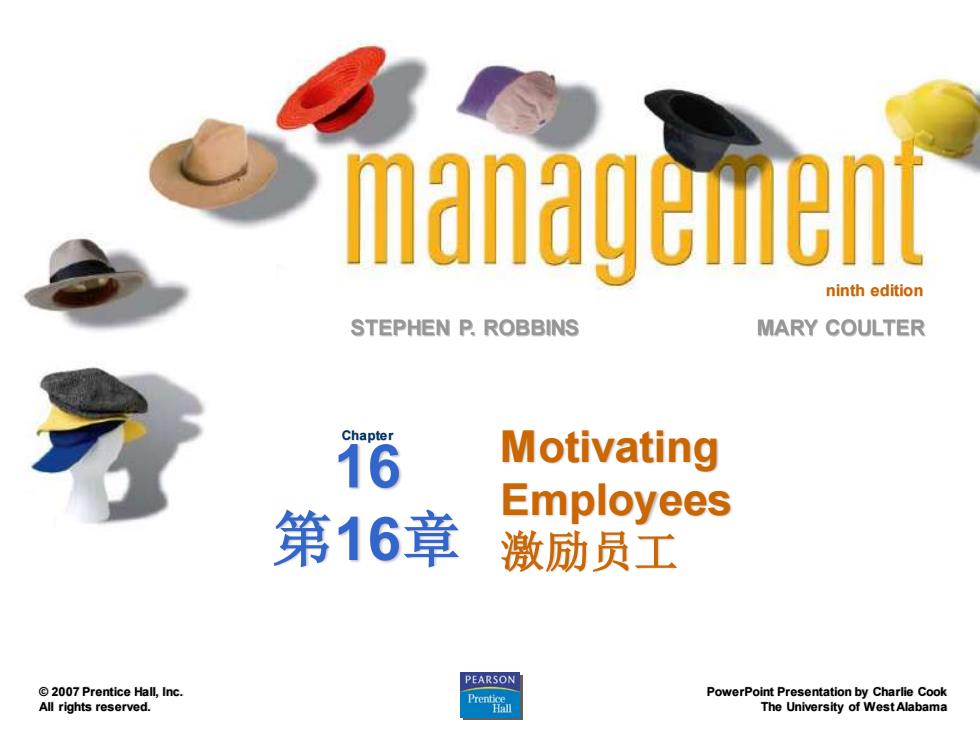
management ninth edition STEPHEN P.ROBBINS MARY COULTER Chapter 16 Motivating Employees 第16章 激励员工 PEARSON 2007 Prentice Hall,Inc. PowerPoint Presentation by Charlie Cook All rights reserved. The University of WestAlabama
ninth edition STEPHEN P. ROBBINS PowerPoint Presentation by Charlie Cook The University of West Alabama MARY COULTER © 2007 Prentice Hall, Inc. All rights reserved. Motivating Employees 激励员工 Chapter 16 第16章
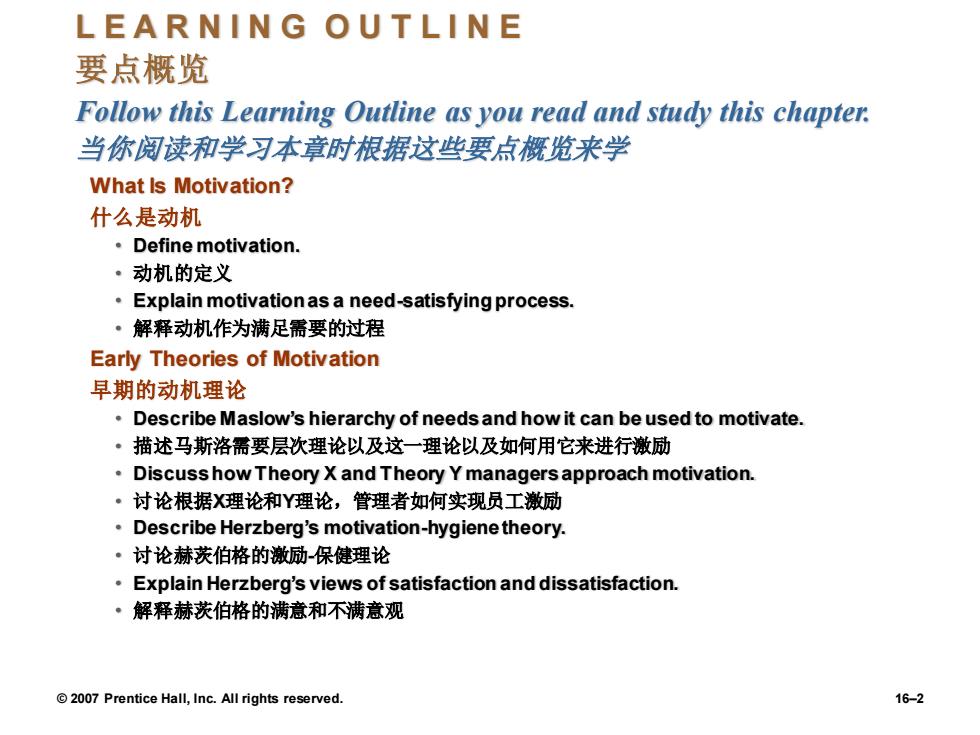
LEARNING OUTLINE 要点概览 Follow this Learning Outline as you read and study this chapter. 当你阅读和学习本章时根据这些要点概览来学 What Is Motivation? 什么是动机 。Define motivation. 。 动机的定义 Explain motivationas a need-satisfying process. ·解释动机作为满足需要的过程 Early Theories of Motivation 早期的动机理论 Describe Maslow's hierarchy of needs and how it can be used to motivate. ·描述马斯洛需要层次理论以及这一理论以及如何用它来进行激励 Discusshow Theory X and Theory Y managers approach motivation. ·讨论根据X理论和Y理论,管理者如何实现员工激励 Describe Herzberg's motivation-hygiene theory. ·讨论赫茨伯格的激励保健理论 Explain Herzberg's views of satisfaction and dissatisfaction. ·解释赫茨伯格的满意和不满意观 2007 Prentice Hall,Inc.All rights reserved. 16-2
© 2007 Prentice Hall, Inc. All rights reserved. 16–2 L E A R N I N G O U T L I N E 要点概览 Follow this Learning Outline as you read and study this chapter. 当你阅读和学习本章时根据这些要点概览来学 What Is Motivation? 什么是动机 • Define motivation. • 动机的定义 • Explain motivation as a need-satisfying process. • 解释动机作为满足需要的过程 Early Theories of Motivation 早期的动机理论 • Describe Maslow’s hierarchy of needs and how it can be used to motivate. • 描述马斯洛需要层次理论以及这一理论以及如何用它来进行激励 • Discuss how Theory X and Theory Y managers approach motivation. • 讨论根据X理论和Y理论,管理者如何实现员工激励 • Describe Herzberg’s motivation-hygiene theory. • 讨论赫茨伯格的激励-保健理论 • Explain Herzberg’s views of satisfaction and dissatisfaction. • 解释赫茨伯格的满意和不满意观
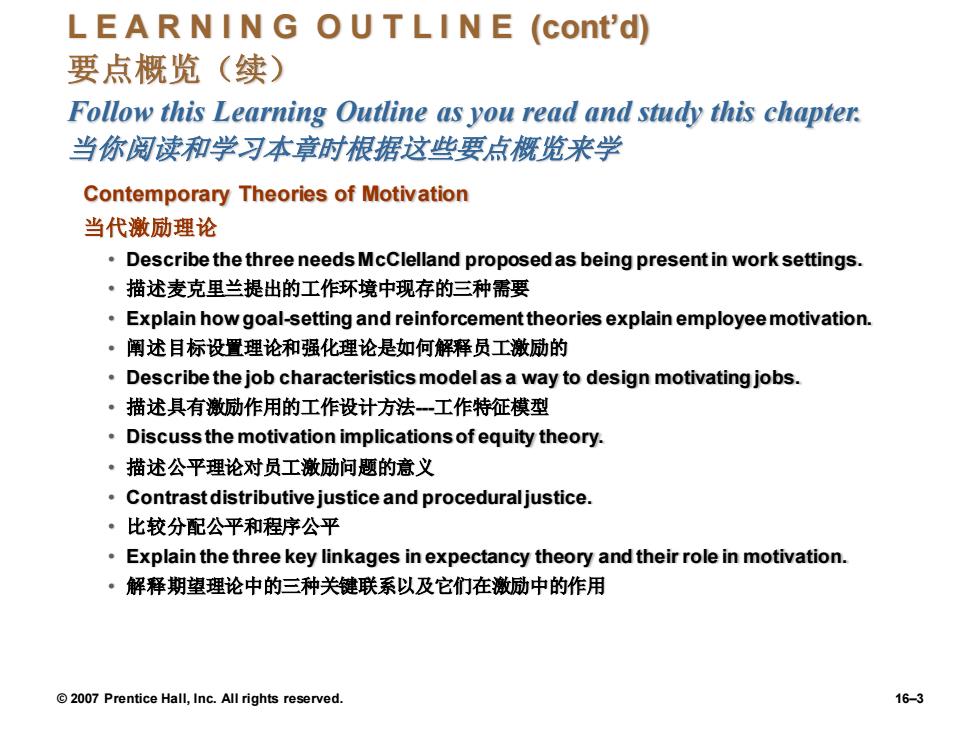
LEARNING OUTLINE (cont'd) 要点概览(续) Follow this Learning Outline as you read and study this chapter. 当你阅读和学习本章时根据这些要点概览来学 Contemporary Theories of Motivation 当代激励理论 Describe the three needs McClelland proposed as being present in work settings. ·描述麦克里兰提出的工作环境中现存的三种需要 Explain how goal-setting and reinforcement theories explain employee motivation. ·阐述目标设置理论和强化理论是如何解释员工激励的 Describe the job characteristics modelas a way to design motivating jobs. ·描述具有激励作用的工作设计方法-工作特征模型 Discuss the motivation implications of equity theory. ·描述公平理论对员工激励问题的意义 Contrast distributive justice and proceduraljustice. ·比较分配公平和程序公平 Explain the three key linkages in expectancy theory and their role in motivation. ·解释期望理论中的三种关键联系以及它们在激励中的作用 2007 Prentice Hall,Inc.All rights reserved. 16-3
© 2007 Prentice Hall, Inc. All rights reserved. 16–3 L E A R N I N G O U T L I N E (cont’d) 要点概览(续) Follow this Learning Outline as you read and study this chapter. 当你阅读和学习本章时根据这些要点概览来学 Contemporary Theories of Motivation 当代激励理论 • Describe the three needs McClelland proposed as being present in work settings. • 描述麦克里兰提出的工作环境中现存的三种需要 • Explain how goal-setting and reinforcement theories explain employee motivation. • 阐述目标设置理论和强化理论是如何解释员工激励的 • Describe the job characteristics model as a way to design motivating jobs. • 描述具有激励作用的工作设计方法-工作特征模型 • Discuss the motivation implications of equity theory. • 描述公平理论对员工激励问题的意义 • Contrast distributive justice and procedural justice. • 比较分配公平和程序公平 • Explain the three key linkages in expectancy theory and their role in motivation. • 解释期望理论中的三种关键联系以及它们在激励中的作用
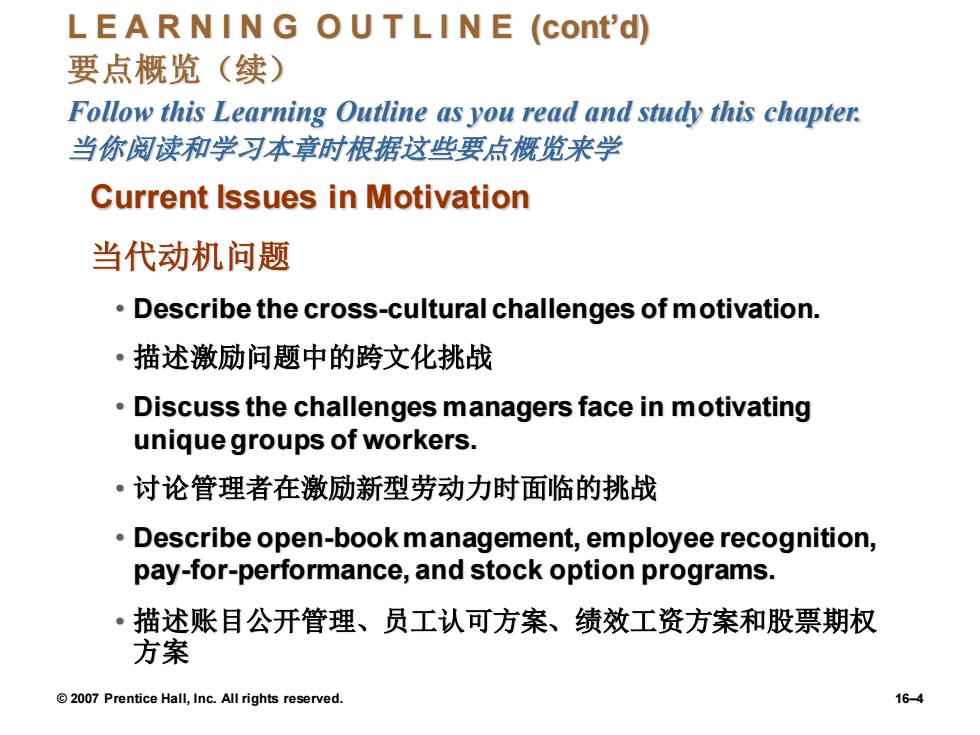
LEARNING OUTLINE (cont'd) 要点概览(续) Follow this Learning Outline as you read and study this chapter. 当你阅读和学习本章时根据这些要点概览来学 Current Issues in Motivation 当代动机问题 Describe the cross-cultural challenges of motivation. ·描述激励问题中的跨文化挑战 Discuss the challenges managers face in motivating unique groups of workers. ·讨论管理者在激励新型劳动力时面临的挑战 Describe open-book management,employee recognition, pay-for-performance,and stock option programs. ·描述账目公开管理、员工认可方案、绩效工资方案和股票期权 方案 2007 Prentice Hall,Inc.All rights reserved. 16-4
© 2007 Prentice Hall, Inc. All rights reserved. 16–4 L E A R N I N G O U T L I N E (cont’d) 要点概览(续) Follow this Learning Outline as you read and study this chapter. 当你阅读和学习本章时根据这些要点概览来学 Current Issues in Motivation 当代动机问题 • Describe the cross-cultural challenges of motivation. • 描述激励问题中的跨文化挑战 • Discuss the challenges managers face in motivating unique groups of workers. • 讨论管理者在激励新型劳动力时面临的挑战 • Describe open-book management, employee recognition, pay-for-performance, and stock option programs. • 描述账目公开管理、员工认可方案、绩效工资方案和股票期权 方案
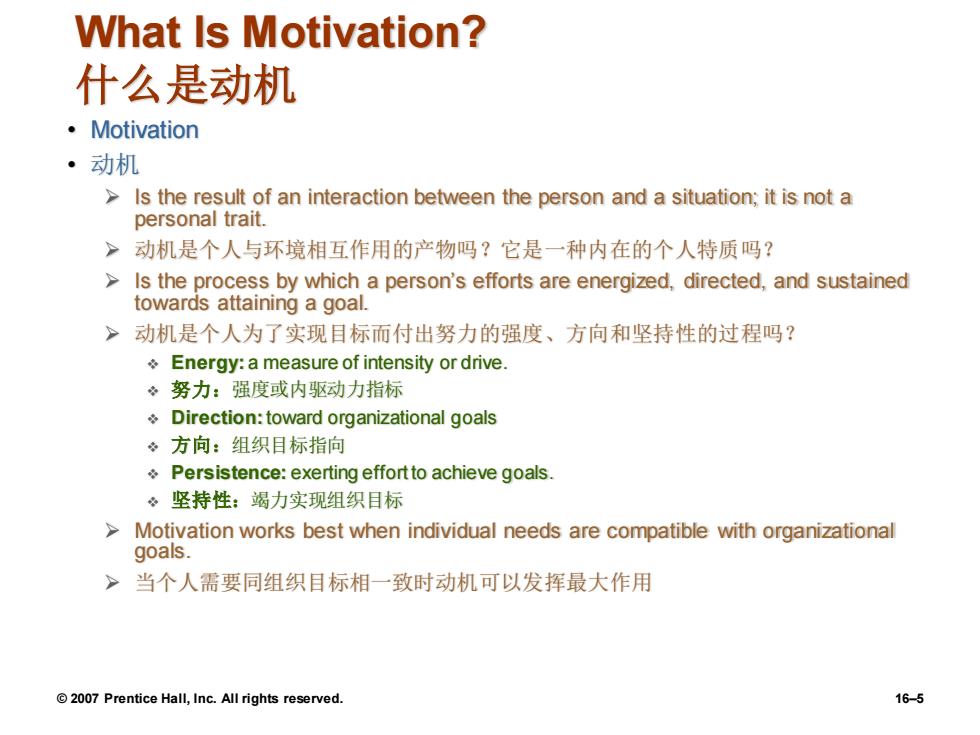
What Is Motivation? 什么是动机 ·Motivation ·动机 Is the result of an interaction between the person and a situation;it is not a personal trait. >动机是个人与环境相互作用的产物吗?它是一种内在的个人特质吗? >Is the process by which a person's efforts are energized,directed,and sustained towards attaining a goal. >动机是个人为了实现目标而付出努力的强度、方向和坚持性的过程吗? Energy:a measure of intensity or drive. 。努力:强度或内驱动力指标 Direction:toward organizational goals 。方向:组织目标指向 Persistence:exerting effort to achieve goals. 。坚持性:竭力实现组织目标 Motivation works best when individual needs are compatible with organizational goals. >当个人需要同组织目标相一致时动机可以发挥最大作用 2007 Prentice Hall,Inc.All rights reserved. 16-5
© 2007 Prentice Hall, Inc. All rights reserved. 16–5 What Is Motivation? 什么是动机 • Motivation • 动机 ➢ Is the result of an interaction between the person and a situation; it is not a personal trait. ➢ 动机是个人与环境相互作用的产物吗?它是一种内在的个人特质吗? ➢ Is the process by which a person’s efforts are energized, directed, and sustained towards attaining a goal. ➢ 动机是个人为了实现目标而付出努力的强度、方向和坚持性的过程吗? ❖ Energy: a measure of intensity or drive. ❖ 努力:强度或内驱动力指标 ❖ Direction:toward organizational goals ❖ 方向:组织目标指向 ❖ Persistence: exerting effort to achieve goals. ❖ 坚持性:竭力实现组织目标 ➢ Motivation works best when individual needs are compatible with organizational goals. ➢ 当个人需要同组织目标相一致时动机可以发挥最大作用